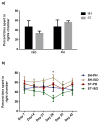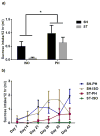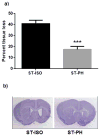Pair housing reverses post-stroke depressive behavior in mice
- PMID: 24793492
- PMCID: PMC4114771
- DOI: 10.1016/j.bbr.2014.04.044
Pair housing reverses post-stroke depressive behavior in mice
Abstract
Social isolation (SI) has been linked epidemiologically to high rates of morbidity and mortality following stroke. In contrast, strong social support enhances recovery and lowers stroke recurrence. However, the mechanism by which social support influences stroke recovery has not been adequately explored. The goal of this study was to examine the effect of post-stroke pair housing and SI on behavioral phenotypes and chronic functional recovery in mice. Young male mice were paired for 14 days before a 60 min transient middle cerebral artery occlusion (MCAO) or sham surgery and assigned to various housing environments immediately after stroke. Post-stroke mice paired with either a sham or stroke partner showed significantly higher (P<0.05) sociability after MCAO than isolated littermates. Sociability deficits worsened over time in isolated animals. Pair-housed mice showed restored sucrose consumption (P<0.05) and reduced immobility in the tail suspension test compared to isolated cohorts. Pair-housed stroked mice demonstrated significantly reduced cerebral atrophy after 6 weeks (17.5 ± 1.5% in PH versus 40.8 ± 1.3% in SI; P<0.001). Surprisingly, total brain arginase-1, a marker of a M2 "alternatively activated" myeloid cells was higher in isolated mice. However, a more detailed assessment of cellular expression showed a significant increase in the number of microglia that co-labeled with arginase-1 in the peri-infarct region in PH stroke mice compared to SI mice. Pair housing enhances sociability and reduces avolitional and anhedonic behavior. Pair housing reduced serum IL-6 and enhanced peri-infarct microglia arginase-1 expression. Social interaction reduces post-stroke depression and improves functional recovery.
Keywords: Arginase-1; IL-6; Ischemic stroke; Post stroke depression; Sociability; Social isolation.
Copyright © 2014 Elsevier B.V. All rights reserved.
Conflict of interest statement
Figures











Similar articles
-
Social interaction plays a critical role in neurogenesis and recovery after stroke.Transl Psychiatry. 2014 Jan 28;4(1):e351. doi: 10.1038/tp.2013.128. Transl Psychiatry. 2014. PMID: 24473442 Free PMC article.
-
Social isolation after stroke leads to depressive-like behavior and decreased BDNF levels in mice.Behav Brain Res. 2014 Mar 1;260:162-70. doi: 10.1016/j.bbr.2013.10.047. Epub 2013 Nov 5. Behav Brain Res. 2014. PMID: 24211537 Free PMC article.
-
Inhibition of interleukin-6 abolishes the promoting effects of pair housing on post-stroke neurogenesis.Neuroscience. 2015 Oct 29;307:160-70. doi: 10.1016/j.neuroscience.2015.08.055. Epub 2015 Sep 3. Neuroscience. 2015. PMID: 26327363
-
The oxytocin receptor is essential for the protective effect of pair housing on post-stroke depression in mice.Exp Gerontol. 2024 Jun 1;190:112432. doi: 10.1016/j.exger.2024.112432. Epub 2024 Apr 12. Exp Gerontol. 2024. PMID: 38614224
-
Impact of social isolation on corticosterone release and recovery after stroke in aged rats: A behavioral and biochemical analysis.Exp Gerontol. 2024 Jul;192:112453. doi: 10.1016/j.exger.2024.112453. Epub 2024 May 14. Exp Gerontol. 2024. PMID: 38723916
Cited by
-
Social interaction modulates the neuroinflammatory response to global cerebral ischemia in male mice.Brain Res. 2017 Oct 15;1673:86-94. doi: 10.1016/j.brainres.2017.08.008. Epub 2017 Aug 12. Brain Res. 2017. PMID: 28807664 Free PMC article.
-
Structure-Activity Relationship and Neuroprotective Activity of 1,5-Dihydro-2H-naphtho[1,2-b][1,4]diazepine-2,4(3H)-diones as P2X4 Receptor Antagonists.J Med Chem. 2022 Oct 27;65(20):13967-13987. doi: 10.1021/acs.jmedchem.2c01197. Epub 2022 Sep 23. J Med Chem. 2022. PMID: 36150180 Free PMC article.
-
Social enrichment attenuates chemotherapy induced pro-inflammatory cytokine production and affective behavior via oxytocin signaling.Brain Behav Immun. 2020 Oct;89:451-464. doi: 10.1016/j.bbi.2020.07.032. Epub 2020 Jul 29. Brain Behav Immun. 2020. PMID: 32735935 Free PMC article.
-
Nano-particle delivery of brain derived neurotrophic factor after focal cerebral ischemia reduces tissue injury and enhances behavioral recovery.Pharmacol Biochem Behav. 2016 Nov-Dec;150-151:48-56. doi: 10.1016/j.pbb.2016.09.003. Epub 2016 Sep 13. Pharmacol Biochem Behav. 2016. PMID: 27619636 Free PMC article.
-
Ischemic stroke induces gut permeability and enhances bacterial translocation leading to sepsis in aged mice.Aging (Albany NY). 2016 May;8(5):1049-63. doi: 10.18632/aging.100952. Aging (Albany NY). 2016. PMID: 27115295 Free PMC article.
References
-
- Glass TA, Matchar DB, Belyea M, Feussner JR. Impact of social support on outcome in first stroke. Stroke; a journal of cerebral circulation. 1993;24:64–70. - PubMed
-
- Glass TA, Maddox GL. The quality and quantity of social support: stroke recovery as psycho- social transition. Social science & medicine. 1992;34:1249–61. - PubMed
-
- Ditzen B, Schmidt S, Strauss B, Nater UM, Ehlert U, Heinrichs M. Adult attachment and social support interact to reduce psychological but not cortisol responses to stress. Journal of psychosomatic research. 2008;64:479–86. - PubMed
-
- Hinojosa R, Haun J, Hinojosa MS, Rittman M. Social isolation poststroke: relationship between race/ethnicity, depression, and functional independence. Topics in stroke rehabilitation. 2011;18:79–86. - PubMed
Publication types
MeSH terms
Substances
Grants and funding
LinkOut - more resources
Full Text Sources
Other Literature Sources
Research Materials

